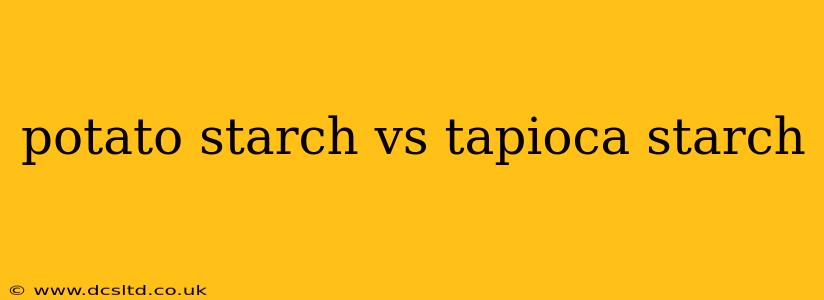Choosing between potato starch and tapioca starch can feel overwhelming, especially with the sheer number of recipes calling for one or the other. Both are excellent thickening agents, but their properties differ subtly, impacting the final outcome of your culinary creations. This comprehensive guide will dissect the key distinctions between potato starch and tapioca starch, helping you make informed decisions in the kitchen.
What is Potato Starch?
Potato starch, as its name suggests, is derived from potatoes. It's a pure starch, meaning it's primarily composed of amylose and amylopectin, the two types of starch molecules. Potato starch boasts a relatively high amylose content, which contributes to its excellent thickening power and its ability to create a clear, translucent gel. This characteristic makes it ideal for certain applications where clarity is crucial.
What is Tapioca Starch?
Tapioca starch, also known as tapioca flour, is extracted from the cassava root. Unlike potato starch, tapioca starch is predominantly composed of amylopectin, resulting in a different texture and thickening behavior. It creates a softer, more tender gel than potato starch, and it has a slightly sweeter taste. Because of its lower amylose content, it tends to form a more opaque gel.
Potato Starch vs. Tapioca Starch: Key Differences
Here's a table summarizing the primary differences between potato starch and tapioca starch:
| Feature | Potato Starch | Tapioca Starch |
|---|---|---|
| Source | Potatoes | Cassava Root |
| Amylose Content | Higher | Lower |
| Amylopectin Content | Lower | Higher |
| Thickening Power | Strong, forms a clear gel | Moderate, forms an opaque gel |
| Texture | Clear, firm, slightly chewy | Soft, tender |
| Taste | Neutral | Slightly sweet |
| Heat Stability | Good | Good |
| Freezing Stability | Good | Good |
Which Starch is Right for My Recipe?
The best starch depends entirely on the desired outcome:
-
Potato starch excels in recipes where clarity and a firm texture are desired, such as pie fillings, sauces that need to be translucent, and some glazes. Its strong thickening power means you need less to achieve the desired consistency.
-
Tapioca starch is preferable in recipes requiring a soft, tender texture, like puddings, custards, and some Asian-inspired dishes. Its mild sweetness adds a subtle nuance to desserts.
What are the Uses of Potato Starch?
Potato starch is frequently used in:
- Soups and sauces: To thicken without clouding the broth.
- Pie fillings: For a clear, glossy finish.
- Glazes: To add shine and viscosity.
- Gluten-free baking: As a thickener and binder.
What are the Uses of Tapioca Starch?
Tapioca starch shines in:
- Puddings and custards: For a smooth, creamy texture.
- Asian cuisine: To thicken sauces and gravies.
- Gluten-free baking: Often combined with other starches.
- Thickening fruit fillings: It produces a less firm gel than potato starch.
Is one healthier than the other?
Both potato starch and tapioca starch are essentially pure carbohydrates and offer similar nutritional profiles. Neither is inherently "healthier" than the other; their suitability depends on individual dietary needs and preferences.
Can I substitute one for the other?
While you can sometimes substitute one for the other, the results may vary. Due to the differences in thickening power and texture, a direct substitution isn't always ideal. You may need to adjust the quantity to achieve the desired consistency. Generally, you'll need more tapioca starch than potato starch to achieve the same thickening effect.
Conclusion
Understanding the nuances of potato starch and tapioca starch empowers you to elevate your cooking. By carefully considering the desired texture and clarity, you can select the perfect starch for your recipe, achieving professional-quality results every time. Remember to always refer to your specific recipe for the correct amount and type of starch to ensure success.
